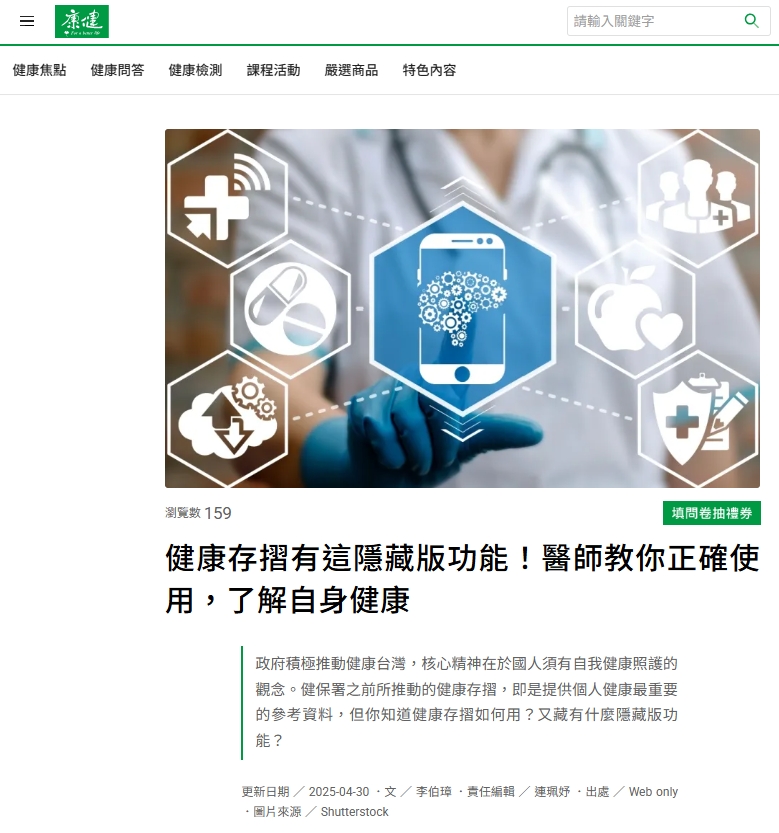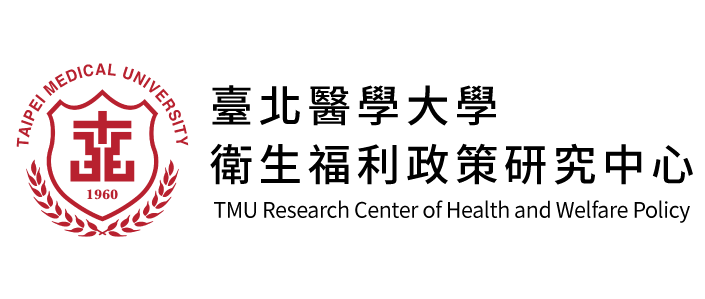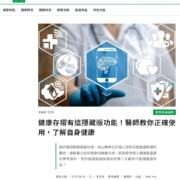【Column article】CommonHealth”Lee Po-Chang’s Column|The Hidden Function of the Health Record! A Doctor Teaches You How to Use It Properly and Understand Your Own Health”

There Is a Direct Link Between Unhealthy Life Expectancy and the Quality of Chronic Disease Care
Improving the family medicine system to ensure that all patients with chronic conditions receive better medications and medical care is a key goal for both the medical community and the government.
However, healthcare is no longer solely the responsibility of the medical system. There is now a stronger emphasis on personal responsibility in self-care. At its core, this concept means that individuals should take proactive and ongoing responsibility for maintaining and promoting their own health.
The Health Record Stores Your Personal Test and Examination Data
To engage in self-care, individuals must first have access to their own test and examination data. Recognizing this need, during my tenure at the National Health Insurance Administration (NHIA), I promoted the launch of the NHI Express / My Health Bank App. Among all government-developed apps, this is the one with the highest number of users.
The My Health Bank app stores each person’s past three years of records, including outpatient visits (Western medicine, traditional Chinese medicine, and dental), prescriptions, laboratory tests, medical imaging, as well as hospitalization and surgical data starting from 2016. This information can be printed or saved to a mobile device and shared with doctors during consultations. It allows physicians to grasp the patient’s healthcare history across different medical institutions, helping to avoid duplicate prescriptions and ensure accurate treatment—thereby improving both safety and effectiveness.
Helpful Reminders and Disease Risk Assessments
The app also includes thoughtful reminder functions for scheduling dental cleanings, adult preventive care, chronic disease prescription refills and follow-ups, reissuing certificates for major illnesses, prenatal check-ups, and child preventive health visits. Users can enable push notifications through the app.
In addition, the disease assessment feature uses test results to calculate values such as liver cancer risk prediction and end-stage renal disease evaluation, helping users better understand their current health risks.
Parents Can Also Manage the Health Records of Their Children or Elderly Parents
For patients with diabetes or early-stage chronic kidney disease who are already under medical care, the app allows them to view their regularly monitored health indicators. Users who have children or elderly family members can also utilize the Family Member Management feature. After completing a strict authorization process, they can switch to view their family members’ My Health Bank records. This makes it easier to help family members understand their health conditions and also provides access to the National Health Insurance Administration (NHIA) website to view information on previously visited medical institutions, such as addresses, clinic hours, and available services.
How to Apply for My Health Bank
When the My Health Bank was first designed, the NHIA took into account the privacy and convenience features similar to those required when applying for a mobile phone plan. In Taiwan, applying for a mobile phone plan typically requires two forms of identification (with the National ID card being mandatory, and the NHI card commonly used as the second document). The telecom provider must also verify the applicant’s identity in person.
Therefore, if you are using a postpaid mobile number registered under your own name, you can easily authenticate your device for the app by preparing the card number at the lower left of your NHI card and entering the following three pieces of information according to the app’s instructions:
-
The last four digits of your NHI card number
-
Your mobile phone number
-
Your National ID or Alien Resident Certificate number
You then set a password to complete the mobile device authentication process with ease.
For those using a corporate phone number—where the phone bill is paid directly by your employer—you’ll need the same three items as above plus:
-
The household registration number from your household certificate
-
The unified business number of your NHI-insured employer
Once these are entered and a password is set, you can complete the online real-name verification and begin accessing all the app’s features.
Hidden Feature: View Annual Radiation Exposure from Medical Scans
Beyond its easy application process and rich data features, My Health Bank also contains a lesser-known, hidden function. In Taiwan, cancer has long been the leading cause of death, and the fear of cancer has led many people to undergo full-body checkups annually—often including CT scans.
However, excessive imaging does not necessarily lead to earlier cancer detection and may instead increase radiation exposure. Over time, this can damage DNA and elevate cancer risk. Studies have already shown that radiology technicians face a higher risk of cancer, which is why their safety protocols have been continually improved.
Radiation exposure—even at low levels—carries a risk of cancer and genetic damage. According to the International Commission on Radiological Protection (ICRP), exposure to 1,000 millisieverts (mSv) of radiation carries a 5% fatal cancer risk, and individuals exposed to more than 100 mSv per year are considered high-risk for developing cancer.
Given the public’s relatively low awareness of radiation risks, the NHIA began displaying radiation exposure amounts from various diagnostic exams in the My Health Bank app at the end of 2021, with support from the Atomic Energy Council. Even though radiologists often emphasize that the dose is minimal and poses no health threat, undergoing unnecessary imaging repeatedly does increase cancer risk. With this information now included, users can see how much radiation they’ve been exposed to annually.
Ultimately, the purpose of radiological exams is to provide valuable diagnostic information, and the medical benefit outweighs the radiation risk. Physicians arrange such exams based on clinical judgment. However, if individuals are aware of the risks, they can avoid excessive or unnecessary imaging—saving healthcare resources and protecting their own health.
If there is any concern about the necessity of a scheduled exam, patients are encouraged to discuss it with their physician for clarification. This approach promotes peace of mind and reflects the personal responsibility one should take in their own healthcare.
Original article source:https://www.commonhealth.com.tw/blog/6164



